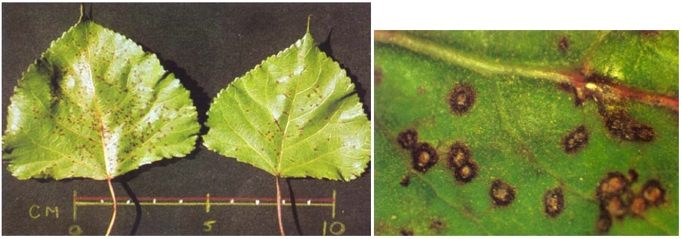PESTS AND DISEASES OF FORESTRY IN NEW ZEALAND
Poplar anthracnose
Poplar anthracnose,
Forest Pathology in New Zealand No. 19.
Based on A.G. Spiers (1989)
Causal organisms
Marssonina brunnea (Ellis & Everhart) Magnus
Marssonina castagnei (Desmazières & Montagne) Magnus

Fig. 1 - Trees of Populus alba (Silver poplar) suffering premature defoliation as a result of infection by Marssonina castagnei.
Type of injury
Leaf spots which can result in premature defoliation (Fig. 1) and branch and twig lesions, all of which can lead to dieback. Tree growth is reduced and eventually, in severe cases, tree death occurs.
Diagnostic features
Marssonina brunnea:
- Small (1-2 mm diameter), black, circular to angular spots on both leaf surfaces (Fig. 2). When infection is heavy leaf spots merge and form irregular-shaped necrotic patches.
- Elongate (up to 10 mm long) lesions which develop white raised centres on young shoots of highly susceptible species and clones.
- Circular (3-5 mm diameter) lesions with white raised centres on 1-2 year-old shoots (Fig. 3).
- Dieback of shoots when girdled by lesions.
Marssonina castagnei:
- Circular to irregular lesions (up to 5 mm) which expand to form chestnut-brown blotches on upper leaf surfaces.
- White masses of conidia on lesions after moist weather.
- Confined largely to Populus alba and its hybrids.

Fig. 2 - Above: leaves of Populus sp. infected with M. brunnea. Right: leaf of P. deltoides x P. nigra seedling
exhibiting typical circular black spots of M. brunnea. The whitish deposits in the centre of the lesions are masses of
conidia.

Fig. 3 - Lesions on stem of a 2-year-old P. deltoides seedling infected with M. brunnea.
Hosts
Marssonina brunnea has an extremely wide host range, being pathogenic to most species of poplar. Only species of the Populus subsections Trepidae (P. tremula, P. tremuloides) and Albidae x Trepidae (P. x canescens) are not susceptible to infection. Other species show various levels of susceptibility (Table 1).
Marssonina castagnei has a narrow host range. Populus alba cv. 'Silver poplar' is very badly affected. Most other cultivars of P. alba are resistant (Table 1).

NI = Not infected.
R = Resistant: few lesions, no leaf necrosis.
S = Susceptible: many lesions, some leaf necrosis (20%).
HS = Highly susceptible: extensive leaf necrosis, premature defoliation
For susceptible plants the degree of infection and subsequent damage may be modified considerably by the amount of disease inoculum overwintering in the area, and by summer climactic conditions (particularly variations in rainfall and relative humidity).
Distribution
Marssonina brunnea was accidently introduced into New Zealand on poplar seed imported from Holland in 1976. The fungus has spread slowly from Palmerston North and by 1986 was present throughout New Zealand. The disease is worst in regions with high spring and summer rainfall, such as Taranaki and the West Coast.
No evidence of M. castagnei was found during a survey carried out in March 1984, yet by December 1986 the fungus was found to be widespread on P. alba cv 'Silver poplar' throughout New Zealand. It is thought that trans-Tasman wind currents carried the fungus from Australia, where it was first recorded early in 1984. Spores were probably distributed simultaneously throughout New Zealand.
Disease development
The small black spots of M. brunnea can be found on the leaves from early spring and these gradually increase in size until, by late autumn, large blotches have formed. The fungus overwinters on such lesions on branches and twigs and on the leaves of evergreen and semi-evergreen poplars. Spores also overwinter on dead infected leaves on the ground. In early spring, spores are spread on to new leaves by wind-blown rain and water-splash. If ample free moisture is available sporulation is profuse and infection levels increase rapidly.
The development of M. castagnei is similar to that of M. brunnea except that shoots are not attacked. The fungus overwinters on its principal host P. alba cv 'Silver poplar' as spores in bud tissues. New infections occur within a month of leaf flush in spring.
Sexual stages of the Marssonina species have not been observed in New Zealand.
Economic importance
The effects of Marssonina infection are cumulative; infected susceptible trees remain infected and are progressively weakened by repeated attacks. Many trees of the highly susceptible 'Silver poplar' cultivar of P. alba have died. Fortunately most other cultivars of P. alba are resistant to M. castagnei.
Control
The primary method of control is the use of resistant clones. Breeding and selection of poplars resistant to Marssonina spp. has been carried out and the disease is not a major problem in New Zealand.
Infections of M. brunnea can be effectively controlled by monthly applications of chlorothalonil, dodine or thiophanate applied at a concentration of 1% active ingredient. Chemical control is, however, often impractical on large trees.
Bibliography
Gadgil, P.D. 2005: Fungi on trees and shrubs in New Zealand. Fungi of New Zealand Volume 4. Fungal Diversity Research Series 16: 1-437
Spiers, A.G. 1983: Host range and pathogenicity studies of Marssonina brunnea to poplars. European Journal of Forest Pathology 13: 181-196.
Spiers, A.G. 1983: Host range and pathogenicity studies of Marssonina castagnei to poplars. European Journal of Forest Pathology 13: 218-227.
Spiers, A.G. 1989: Poplar anthracnose. New Zealand Ministry of Forestry, Forest Pathology in New Zealand No. 19.
Spiers, A.G. 1998: Melampsora and Marssonina pathogens of poplars and willows in New Zealand. European Journal of Forest Pathology 28: 233-240.
Ridley, G.S., Dick, M. 2001: An introduction to the diseases of forest and amenity trees In New Zealand. Forest Research Bulletin 220, Rotorua, New Zealand.
Compiled: 1989. Reviewed 2009.

 Farm Forestry New Zealand
Farm Forestry New Zealand

